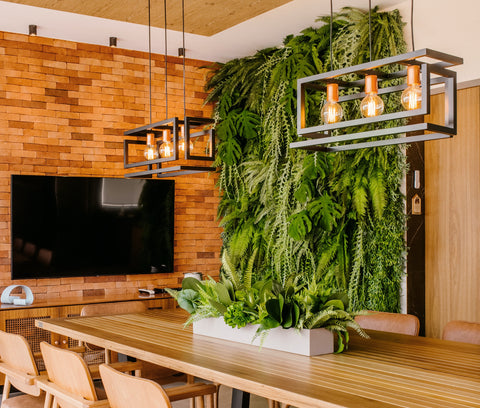Biophilic Design & The Power of Indoor Plants In Our Homes

Biophilia, translating to “love of life”, is the evolutionary adaptation that explains the connection humans have with nature and living things. The term was coined in the 1960s and later expounded upon with the how the outdoor world captivates through colors, shapes, textures, smells, and sounds. But the basis of the idea has existed since the beginnings of human life. The term biophilic design was then developed, describing how built-environments can benefit by integrating design concepts from nature.
Biophilic design is far reaching and draws from natural elements such as sunlight (think: floor to ceiling windows), earth (including natural materials like woods and stones), and airy aspects (like open floor plans). Before the rise of industrialization and technology, early humans (most notably hunter-gathers) lived among the plants and animals, utilizing nature’s viable resources to live. Nowadays the concept of biophilic design is foundationally to bring aspects of the outdoors inside, creating a more intrinsically pleasing indoor environment.

Part of biophilic design can be attributed to how certain elements of nature elicit a response. For instance, the color green has an immense impact on the way humans feel– it’s a comforting hue. And that’s likely an innate response that we adapted over time to associate with nature and safety. For example, seeing a lush green pasture could have related to feelings of prosperity (food/water sources) and protection (home materials).
Beyond ingrained reactions, numerous studies have shown that plants can have a calming effect on us physiologically and psychologically, all while boosting mood and wellbeing. We’ve also seen how practices of forest bathing, nature walks, and earth grounding can shift a person’s mood– eliciting a positive response on a physical, mental, and emotional level. So in order to make our indoor spaces best serve us, biophilic design draws upon nature to create a functional and healthy environment. The goal being to reduce common stressors and increase healthful aspects within the built-environment– living optimally.

Perhaps the most fascinating aspect of human connection to nature, is the recurrent existence of the Fibonacci series in the wild. The satisfying numerical sequence is exhibited through certain plant structures, like leaf formation. The human subconscious mind is attracted to the Fibonacci proportions and the concept is often used in architectural designs. Here, we’ll focus on one of the most approachable ways to implement nature into your space without undergoing significant or structural changes– and that’s plant-related greenery (and the light that plants need).
Despite this innate pull to live in tandem with nature, half of the world lives in urbanized cities. And with Americans spending about 90% of their time indoors, it’s apparent that we need to incorporate more nature into our daily routine. With biophilic design, nature is brought to you through innovative concepts drawn from biophilia. Here are 4 seamless ways to add a touch of greenery, a bit of the outside, into your indoor space.

1. Houseplants
One of the easiest ways to greenify your home or office without making huge changes, is to include houseplants. Not only does the mere presence of plants (and the color green) increase wellbeing, but the act of caring for plants has a significant effect on mental health. Plants could also help boost the wellness-factor of your indoor environment by cleaning the air of harmful particles.
If you’re new to plants, try a beginner-friendly option like the ZZ plant or snake plant. As a bonus, the snake plant releases oxygen at night, so it makes a great bedroom plant!

2. Edible Herbs
Satisfying the senses of smell and taste, the inclusion of edible plants can take your indoor space to the next level. We tend to associate visual, auditory, olfactory, tactile, and gustatory factors with being in nature– the greenery we see, the rustling of leaves we hear, the flowers we smell, the way the grass feels under our feet, and the taste of nature’s bounty. So by bringing aspects of nature indoors, we’re inviting earthy, necessary, sensory experiences.
Try growing basil, rosemary, or your favorite herb near a windowsill. Not only will having it around infuse an herbal aroma into the air, but adding to your meals can excite the taste buds.

3. Natural Light
Your levels of sunlight are going to be fixed in your unique space, but there are ways to play around with light. Light is a vital source of energy, and has been associated indoors with increased alertness, reduced blood pressure, lower stress, and regulated sleep– I mean there’s a reason we are drawn to the homes that are flooded with natural light, just ask a realtor.
To amplify the lighting in your space, use mirrors strategically angled to reflect and bounce light around the room. If you live somewhere where you don’t see nature when you look outside, you can optimize your window space (without blocking too much light!). Specifically, if you’re able to plant greenery outside, then add some tall plants around the exterior of windows– that way you can see a pop of green when looking out. It’s a simple design hack that can have a huge physiological and psychological impact!

4. Green Walls
Whether small pieces of moss art or large installments of plant walls, bringing a bit of nature to a vertical structure can instantly greenify your space in a different way. These green pieces can mimic the forest floor or a canopy of lush jungle right inside your home.
While preserved moss frames require zero-maintenance, the live green walls can require some upkeep (or choose a faux option!). These pieces perfectly tackle the task of blending the outside-inside world.

Awesome article